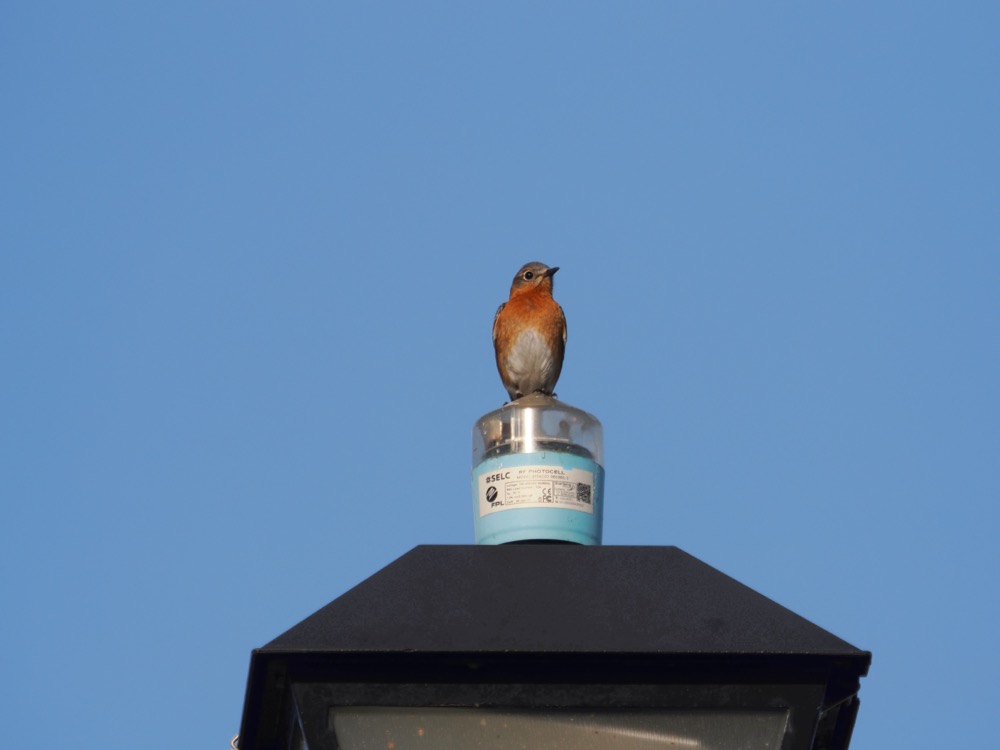
Just needed to post a pic to make sure I remembered how to do it!
It seems giving my E-M10 Mk4 to my son has prompted a broader examination of how I wish to "take pictures" on my morning walk.
For a long time, I was content with the M10 Mk4 and the 14-150mm/f3.5-5.6 because it was a lightweight setup, and I could do pretty much anything with it. It's a close-focusing lens at 150mm, so I could get nice closeups of flowers, lizards or insects. 14mm is equivalent to 28mm full-frame, so I could get some landscapes if I wanted. And 150mm (300mm equivalent) isn't bad for birds, and with 20MP I could crop quite a bit for the little pics I shared.
But then I wanted to get closer to the birds, and the landscapes were pretty monotonous on the walk anyway, so I started carrying the 75-300mm zoom. It's often maligned among micro four-thirds users, but there's sample variation and mine happens to be sharp enough to please me. With the M10 Mk 4, it remained a very lightweight setup, about 1.7 lbs, and I shot with it a lot without experiencing any knots between my shoulders, or spine issues.
Since Monday, I'd been carrying the E-M1 Mk3 with the 75-300mm. That combination weighs about 2.4 lbs. Yesterday I noticed some additional creakiness in my spine, but nothing very alarming. It did seem related to carrying the heavier camera, but I wasn't sure.
So today I decided to try something different. I carried the OM-1 with the 40-150mm/f2.8 Pro, with the MC20 2x teleconverter mounted, which gives me the same reach as the 75-300mm, but a slightly brighter aperture at f5.6 versus f6.7, a half-stop faster. That rig comes in at a whopping 3.5 lbs! (Both the OM-1 and the E-M1 Mk3 have RRS bottom plates mounted.)
The biggest lesson I learned is that that's too heavy for a sling. I could do it in a pinch, but it was uncomfortable by the end of the walk, and my spine has been creaking and popping quite a bit since I got back. Most mornings, I bend over and do a modest inversion, holding my elbows and letting them hang below my head. I can usually feel one or two pops from the lower part of my spine. This morning there were about five, all along my spine! I've got a little muscular discomfort along the left side, just below the shoulder blade. The sling rests on my left shoulder. It's not the same knot that would develop when I carried the camera by my right side with the sling over my left shoulder. The weight vector is more nearly vertical, so there's less of that side-force pushing me out of alignment.
The other thing I learned is that I need to adapt the way I shoot with that combination. Most competent photographers would shoot in shutter priority with a long lens mounted, to minimize the possibility of motion blur in the image.
I've been spoiled by the light weight and excellent image stabilization of Olympus cameras. I normally shoot in aperture priority, with ISO fixed at base and relied on ~4 stops of image stabilization to get a sharp image. My 75-300 is modestly sharper stopped down, but it's pretty sharp in the center wide open. I mentioned I seldom shoot birds in flight, where I would shoot in shutter priority. But for birds just perched on a limb, or standing by the pond in good light, aperture priority usually gets me something IBIS could handle easily, even with a slow lens at long focal lengths.
I found the heavier lens is more challenging, for me, to hold steady. I'd already noticed this with the 100-400mm zoom, but it kind of surprised me with the 40-150. Many people prefer a heavier lens for a steady grip. I suppose there's a sweet-spot for everyone. But it seemed like the image was moving around in the viewfinder a bit more than I'm accustomed to.
A hooded merganser landed in the retention pond just as I was leaving it, so I turned around and tried to get a few shots. It's a dark bird, against a dark water surface and I wasn't paying attention to the shutter speed. I was getting speeds around 1/50s, and those shots weren't sharp at all, a lot of visible motion blur. I suppose the camera was doing okay with the body and lens movement, but the bird was probably bobbing around a bit in the water as well.
They weren't all horrible, though most of them were. I'm going to post one on Flickr that cleaned up fairly well in Topaz Sharpen AI, but it's not something I'd brag about.
In any event, I think I'm going to switch to using shutter priority whenever I have a long lens mounted. If the ISO goes up a couple of stops, no big deal.
The bluebird above seems to persuade me that my 40-150 with the MC20 mounted isn't significantly sharper than my 75-300. I'll have to shoot with it some more, to become more accustomed to how it feels in my hands. I might be able to get something more out of it. But for just taking my morning walk, I think the 75-300 punches above its weight as a "kit" lens, and it's a hell of a lot more comfortable to carry.
Where the 40-150 excels is in on the trail in the woods, where the light is much more challenging. And it's a close-focusing lens as well, so it's great for flowers and fungi and bugs too.
Anyway, I'm glad I'm not carrying full-frame bodies and glass!
Originally posted at Nice Marmot 11:17 Thursday, 9 February 2023